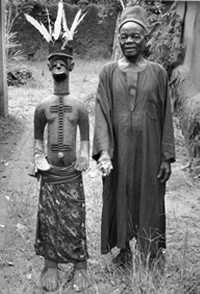ABOVE:
Alusi priest Ezekwem with figure of deity Eke. Both have ichi
marks.
Adazi Ani, Nigeria
Photograph by Herbert M. Cole, 1966
RIGHT:
Male figure (alusi)
Igbo peoples, Nri/Awka region, Nigeria
Late 19th to early 20th century
Wood, pigment
H.
161 cm (63 3/8 in.)
97-17-2, museum purchase
The Igbo number over 16 million people, making them one of Nigeria’s largest ethnic groups. Organized into villages defined by lineage, each Igbo village contains family living quarters, dance areas for public performances, marketplaces and shrines for local deities. The deities, known as alusi, are tutelary or guardian spirits who are the founders of the communities or associated with the earth, rivers or markets. Alusi may be depicted as wooden figures and placed in shrines where they are the subjects of weekly and annual rituals that honor the deities who help a community or family solve problems. Older members of the Igbo community still honor alusi today.
Conceived as a family unit, six or more figures are arranged carefully against the shrine’s interior wall. The principal figure—the “mother” or the “father”—presides over other figures that portray husbands, wives, children and attendants who are named for the founders of important lineage or communities. During the annual “festival of images,” the alusi are repainted and redressed by village women, while guardian figures wearing a profusion of adornments and regalia from different lineage are gathered and paraded through the town as a sign of respect.
This symmetrical figure with its frontal pose most likely represents a tutelary deity and, although its precise meaning has been lost, expresses the Igbo ideal of achievement. His hands extended outward with palms up indicate open-handedness or generosity as well as a willingness to receive sacrifices and other gifts.
![]()

Igbo
shrine figure Ihuokpara Ekwulobia, Nigeria
Photograph by Herbert M. Cole, 1966
The stylized face displays the scarification marks (ichi) of an ozo titleholder at the temples and forehead. The ozo society, the best known of several leadership organizations among the Igbo, places political, moral and spiritual authority with mature, wealthy men. These marks are made by cutting through several layers of skin, a painful procedure that is considered a test of courage. The ichi patterns on the temples and lower forehead resemble eagle wings and may be an allusion to the eagle feathers on the red hats worn by ozo members. The crescent shape in the middle of the forehead refers to the moon, a symbol of fertility and a reference to the earth goddess Ala. It is also an allusion to the continuity and prosperity of the family. The ichi band beneath the crescent refers to the sun and the male sky god with whom the head of the ozo title society identifies.
![]()
The scarification marks on the stomach and chest are for beautification
and indicate the individual was a completely socialized adult who had
undergone rigorous training to become a member of the community. The carved
spirals around the legs represent anklets, which are worn at the prerogative
of the ozo titleholder. The figure was primarily red originally,
probably the result of having been rubbed with camwood, much as the Igbo
do to beautify themselves. Traces of red and ochre are still visible.
White chalk rubbed on the face symbolizes purity, beauty and sanctity.
Although the figure was most often clothed when honored in the shrine,
the detailed scarification of the torso, the leg bangles and the careful
depiction of genitalia are the carver’s way of clearly identifying
the figure.
